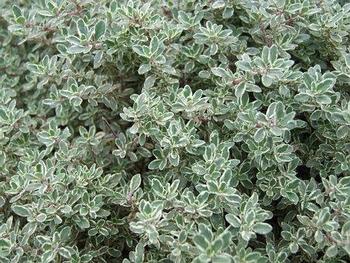Thyme
-
Scientific NameThymus vulgaris
-
General InformationEasy evergreen perennial grows two to 15 inches tall. Tiny fragrant gray-green leaves; some variegated varieties available. Blooms early summer. Tiny lavender, white, or pink flowers taste like the foliage, only sweeter. Attracts bees. Deer resistant. Mediterranean native sometimes called common or English thyme. Withstands cooking without losing flavor.
 Pixabay
Pixabay -
When to Plant
Plant thyme by seeds, starts, or cuttings in late spring and/or early fall. Soil should be 70 degrees.
-
Planting
Plant seeds or cuttings 12 inches apart. Thyme can be challenging to start from seed as it has slow, uneven germination. Starts and cuttings are faster and easier. Propagate thyme by layering. Take a long stem, bend it over, and lay it on the soil. Leave the tip free and secure it with a u-shaped stake. After the roots form, you can cut it from the main plant.
-
Soil Requirements
Prefers sandy, well amended, fast draining soil with a pH between 6.5 and 7, as it prefers slightly alkaline conditions. To raise the pH, you can add lime. Does well in rocky soil and full sun.
-
Water Requirements
Keep plants on the dry side to avoid root rot. In general, water deeply when dry. Thyme does not require much water and is quite drought tolerant. It will not thrive in hot, humid climates.
-
Fertilizing
No fertilizer required. In early spring, simply add a thin layer of compost.
-
Pollination
Flowers are attractive to bees, butterflies, and other pollinating insects. Thyme has chemicals that are antibacterial and anti-fungal that may be beneficial to pollinators.
-
Harvesting
Both leaves and flowers are edible.
Harvest fresh leaves anytime for cooking; for best flavor, harvest before blossoms open. Take fresh stems and leave the tough part, which is usually about five inches of growth. Harvest dried leaves before the plant has flowered.
Use flowers to flavor pastas, salads, soups, butter and oils. Use the leaves for cooking with sauces, meat, fowl, fish and seafood and stuffing.
Thyme is one of the ingredients in herbs de Provence.
-
Storage
Fresh thyme should be wrapped in plastic and refrigerated. It will be good for one to two weeks. To dry thyme, hang the sprigs in a dark, well-ventilated, warm area. When dry, store in an airtight container. Crush just before using. Should last two years. Freezing also works.
-
Good Varieties for Marin
Good for cooking:
English thyme (Thymus vulgaris)
French thyme is a variety of English Thyme with narrower leaves and sweeter flavor
Caraway thyme (Thymus herba-barona) has pink flowers and is fast growing to 2 to 5 inches tall and 2 feet wide. It forms mats and tastes like caraway.
Lemon thyme (Thymus citriodorus) has a lemon flavor, pink flowers, and grows six to 12 inches tall.
Silver thyme (Thymus vulgaris ‘Argenteus’) has variegated silver leaves. Lemon flavor.
Golden lemon thyme (Thymus citriodorus ‘Aureus’) has leaves tinged in gold. Lemon flavor.
-
Helpful Tips
Cut back in spring to keep the plant compact. It will become woody with age and the center starts to die out after a few years. Replace it or propagate cuttings from the old plant. Prune for good air circulation.
Go easy on washing, as it removes some of the essential oils.
Great in a container with rosemary, which has similar needs.
-
Common Problems
Thyme is fairly pest and disease resistant, although spider mites can be a problem in dry weather, and possible fungus diseases in humid climates.
-
Pests- Diseases & More
None noted.

